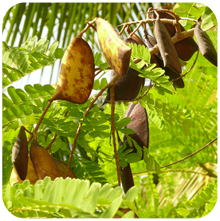
Caesalpinia sappan is a small tree shrub, has 4-8 m average height, trunk up to 14 cm in diameter; bark has distinct ridges and many spines and is brownish-gray in color. Young twigs and buds are hairy and brown.
Leaves are stipule, bipinnate, alternative with 8-16 pairs having up to 20 cm length, pinnae with spine at the base with 10-20 pairs of oblong, 10-20 mm x 6-10 mm long leaflets subsessile, oblique at base, rounded or emarginate at apex.
Flowers in terminal panicles, racemes pubescent, primary peduncles 30-40 cm long, flowering is 9-15 cm long, bracts are ovate-acuminate, about 6 mm in length, fragrant flowers are 2-3 cm long, sepals are glabroous, petals are pubescent, calyx tube is 3 mm long; corolla is yellow, the upper lobes are cuneate, other are obovate. Stamens are 10, filaments densely tomentose in the lower half; ovary is superior, pubescent.
The fruit is a pod, glabrous, thick, flat, has obliquely elongated, prominently as woody, lustrous brown beak, 7-10 cm x 3-4 cm in diameter, with 2-3 seeds. The seed are ellipsoid, flattened, 18-20 mm x 10-12 mm, dark brown in color.
Chemical composition – Contains triterpenoids, flavonoids, oxygen heterocycles, lipids, steroids and amino acids. Also contains Brazilin, the main constituent of the plant as well as sappanin. Protosappanin A is a metabolite of sappan chalcone and the precursor of sappanin. Also contains, several flavonoids and homo-isoflavonoids like ombuin, quercetin, rhamnetin, sappan chalcone, sappanol and its ethers, 8-methoxy bonducellin, caesalpinia chromans, chromanones and chalcones. The biogenetic pathway from sappan chalcone to brazilin via three known homo-isoflavonoids is triterpenes (β-amyrin, taraxerol), stearic acid, palmitic acid, β-sitosterol. Major fatty acids are: linoleic, oleic, palmitic, and linolenic.
Properties – Emenogog, powerful hemostatic, diuretic, antibacterial, anti-inflammatory, astringent, depurative, immunostimulant.
Recommendations – Menorrhagia, leucorrhoea, atonic diarrhea, dysentery, skin infections, wounds, ulcers, anemia, arthritis.
This plant is incorporated in natural remedies KAMAIANY, SHECURE Syrup.




